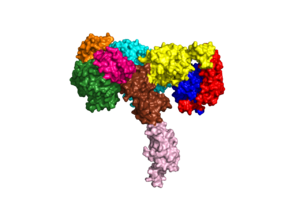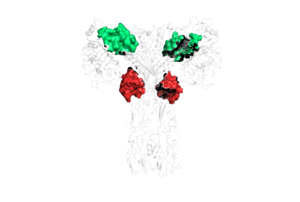Sandbox Reserved 1732
From Proteopedia
| This Sandbox is Reserved from August 30, 2022 through May 31, 2023 for use in the course Biochemistry I taught by Kimberly Lane at the Radford University, Radford, VA, USA. This reservation includes Sandbox Reserved 1730 through Sandbox Reserved 1749. |
To get started:
More help: Help:Editing |
Contents |
Insulin Receptor
|
What is an Insulin Receptor?
An insulin receptor is a large protein that binds to insulin and passes its message into the cell. When insulin binds to the receptor, it is activated and triggers a series of chemical reactions within the cell. These reactions cause an uptake in glucose and other metabolic and growth-related functions [1].The insulin receptor binds to insulin that is produced in our bodies as well as FDA approved designer insulin which allows people with diabetes to maintain the blood sugar levels necessary. Along with controlling homeostasis, insulin receptors also play a crucial role in regulating lipid, protein, and carbohydrate metabolism, as well as modulating brain neurotransmitter levels [2].
Function
Insulin receptors are regions outside of a cell that allow the cell to bind with the insulin in the bloodstream. The main physiological role of insulin receptors is metabolic regulation [3].
In order for the receptors to properly interact with Insulin, Insulin must undergo a conformational change. This conformational change is when the C- terminal of the B chain must disengage from the hormone's core. Now the Insulin can properly bind to the appropriate receptor [4].
Insulin
In order to fully comprehend insulin receptors, it is important to understand what insulin is. Insulin is a hormone that allows our bodies to absorb glucose that is found in our bloodstream. The main source of insulin in the body is from the pancreas, which consists of islets. Islets are what produce and determine the amount of insulin based on the body's blood glucose levels. The higher the glucose levels, the more insulin is produced and released in order to bring blood sugar levels back to an equilibrium [5].
Disease
Diseases that involve insulin receptors are normally due to wrong signaling. Insulin regulates blood glucose levels, and with no regulation, it will lead to diseases such as obesity, type I and type II diabetes. Diabetes mainly happens due to elevated levels of blood glucose levels which can result in serious complications over time if not treated correctly. Insulin receptors will interact with cell surface insulin as a mediator of signaling. Around 10.5% of the US population have diabetes. Most of them have type II diabetes. This type of diabetes is considerably more dangerous as it has to do with lifestyle and not the disease coming from a genetic condition that shows up early in life. People with type II diabetes are more susceptive to being obese due to their lifestyle [6].
Relevance
Insulin secretion and binding to the insulin receptor initiates a robust physiological response in a healthy individual. The correct insulin signaling is important as it regulates many things that include glucose, lipid, and energy homeostasis. Diseases that happen relating to insulin are due to wrong signaling. These include type I diabetes and type II diabetes. Type I diabetes is normally associated with a genetic condition that shows up early in life. Type II diabetes is normally due to a certain unhealthy lifestyle and will develop over time [7].
Structural highlights
An insulin receptor is a dimer of heterodimers. The dimers are noncovalent, but the insulin receptors are covalently maintained as functional dimers by disulfide bonds. An insulin receptor is comprised of 2 α-chains, and 2 β-chains. The α-chain and an estimated 190 residues of the β-chain are located on the extracellular side of the plasma membrane. The rest of the beta-chain consists of a single transmembrane helix, the Juxtamembrane domain, and the intracellular tyrosine kinase domain [8]. The alpha subunits are the site for insulin binding. Each subunit is comprised of 2 Leucine rich domains (L1 and L2), a Cysteine rich domain (CR) and an α-chain C-terminal helix (α-CT). The two subunits are held together by a disulfide bond between the cysteine rich domains. Site L1' is dark green, CR' is orange, L2' is light blue, L2 is yellow, CR is red, L1 is dark blue, β-subunits are brown and light pink, insulin bound to the receptor is hot pink.[9]
Due to the heterodimeric nature of the receptor, there are two types of insulin binding sites that are split into pairs in the alpha subunits: sites 1 and 1' and sites 2 and 2', for a total of 4 binding sites of insulin. Binding sites 1 and 1' have a greater surface area and are more easily accessible for the insulin to bond, resulting in a higher affinity for insulin binding. Binding sites 2 and 2' have less surface area and are located on the back of the beta sheet so their binding sites do not get filled as quickly.The beta subunits consist of Fibronectin domain III-2 (FnIII-2) and Fibronectin domain III-3 (FnIII-3). In the image below, Sites 1 and 1' are green. Sites 2 and 2' are red [10].
There are two main conformations of full-length insulin receptors, U-shaped and T-shaped. The U-shaped conformation exists when there is an absence of insulin on the protein, whereas the T-shaped and II-shaped conformations exist in the presence of insulin. The U-shaped conformation is also known as the auto-inhibited state. In this state, the L1 domain contacts the L1’ and L2’ domains of the partnering protein. When insulin binds to the receptor protein, it causes a conformational change from the U-shape to the T-shape conformation [11].
References
1 Goodsell, D. PDB101: Molecule of the month: Insulin receptor. https://pdb101.rcsb.org/motm/182 (accessed Nov 7, 2022).
2 PF;, L.J.P. (no date) The insulin receptor: Structure, function, and signaling, The American journal of physiology. U.S. National Library of Medicine. Available at: https://pubmed.ncbi.nlm.nih.gov/8141246/ (Accessed: October 21, 2022).
3 Felman, A.; Prelipcean, M. Insulin: Function and types. https://www.medicalnewstoday.com/articles/323760 (accessed Nov 1, 2022).
4 PDB101: Global health: Diabetes mellitus: Drugs: Insulin: Insulin receptor https://pdb101.rcsb.org/global-health/diabetes-mellitus/drugs/insulin/insulin-receptor#:~:text=Insulin%20receptors%20are%20proteins%20found,metabolic%20and%20growth%2Drelated%20functions. (accessed Oct 21, 2022).
5 Boucher, Jérémie. Kleinridders, André. Kahn1, C. Ronald. Insulin Receptor Signaling in Normal and Insulin-Resistant States. https://cshperspectives.cshlp.org/content/6/1/a009191 (accessed Nov 14, 2022).
6 Scapin, G.; Dandey, V. P.; Zhang, Z.; Prosise, W.; Hruza, A.; Kelly, T.; Mayhood, T.; Strickland, C.; Potter, C. S.; Carragher, B. Structure of the insulin receptor–insulin complex by single-particle cryo-EM analysis. https://www.nature.com/articles/nature26153 (accessed Nov 7, 2022).
7 Kasago, Masuta. Hedo, Jose A. Yamada, Kenneth M. Kahn, C. Ronald. The Structure of Insulin Receptor and Its Subunits. https://www.jbc.org/article/S0021-9258(18)34032-8/pdf (accessed Oct 21, 2022).
8 Lee, J. and Pilch, P. F. The insulin receptor: structure, function, and signaling. https://journals.physiology.org/doi/abs/10.1152/ajpcell.1994.266.2.c319 (accessed Oct 21, 2022).
9 Lee, Yong Hee and Morris F. White. Insulin Receptor Substrate Proteins and Diabetes. https://link.springer.com/content/pdf/10.1007/BF02980074.pdf (accessed Nov 14, 2022)
10 Lawrence, M. C. Understanding insulin and its receptor from their three-dimensional structures https://www.ncbi.nlm.nih.gov/pmc/articles/PMC8513149/#bib1 (accessed Oct 21, 2022).
11 Hubbard, Stevan R. Wei, Lei. Ellis, Leland. Hendrickson, Wayne A. https://www.nature.com/articles/372746a0 (accessed Oct 21, 2022).


